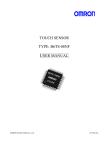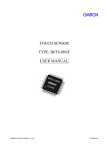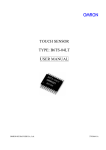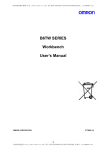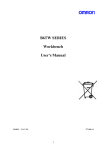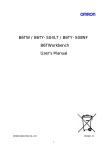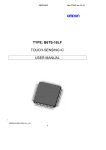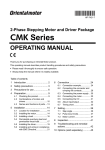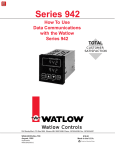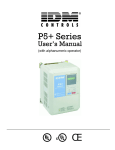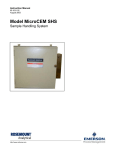Download TYPE: B6TS-08LF TOUCH-SENSING IC USER MANUAL
Transcript
3713050-2A
TYPE: B6TS-08LF
TOUCH-SENSING IC
USER MANUAL
OMRON KURAYOSHI Co., Ltd.
1
Ver.080123
3713050-2A
Ver.080123
Introduction
Thank you very much for purchasing the touch sensor.
The touch sensor is a product that has been developed based on our advanced technology and rich experience.
This user manual describes the information necessary for use of the sensor, such as its functions, capabilities and proper
usage.
When using the touch sensor, please keep the following in mind:
・Only specialists with knowledge of electricity must handle the touch sensor.
・Please read and understand the contents of this manual thoroughly to use the touch sensor appropriately.
・Keep this manual handy to refer to it again later on specific problems.
Points to note when using the touch sensor
・
Although OMRON makes constant efforts to improve the quality and reliability of its semiconductor products, products
such as this touch sensor may malfunction or break.
Before using the touch sensor, please contact OMRON’s business development personnel, if necessary, to confirm
product specifications, while also paying attention to using the sensor with a sufficient margin allowed for its ratings
and capabilities, and taking safety measures such as installing safety circuits to minimize hazards in the unlikely event
that a failure of the sensor might occur.
・ Basically, this product is not designed and manufactured for use in equipment or systems operated under potentially
hazardous conditions. If you intend to use the touch sensor with any of the following systems, facilities or equipment,
be sure to consult OMRON sales personnel or an agent or dealership first:
(A) Atomic power control equipment, incineration facilities, railroads, aircraft, vehicle equipment, medical
appliances, amusement machines, safety devices, and facilities that must comply with the regulations of
administrative agencies and their respective industries.
(B) Systems, machines and devices that are potentially hazardous to humans and property.
(C) Other usages that require a high degree of safety.
The technical information contained in this manual is prepared only to describe typical performances and
application examples of the product. Application of the products based on the information does not infer the
grant of any OMRON or third party intellectual property, right or license.
1. Preventing malfunction caused by contact with an electric conductor other than a human finger with the touch
electrode
Because this product measures the electrostatic capacitance of the detector (electrode), the product may
operate if something other than a human finger is brought into contact with the electrode. Therefore, a fail-safe
design is required for use of the product so that it does not cause any functional or safety problem even on
such occasions. Substances, etc., that may cause a malfunction if they are present near to or on the detector
are:
・ Water, metal, animals, other conductive materials
2. Preventing operational error
Because this product detects human touch, it may operate if the detector (electrode) is touched only lightly or if
somebody remains nearby. When incorporating this product into a device, check the detection range
thoroughly, and employ measures to prevent the device from malfunctioning caused by operational error.
Especially, if the device is used where children may come into contact with it, provide some safety measure
such as a child safety lock.
3. Preventing the entry of water or corrosive gases
If water or a corrosive gas enters the operating part of the sensor (electrode), in the event of a short circuit or
corrosion of the electrode, the sensor may malfunction or its detection sensitivity may be lowered. If the product
is supposed to be used in an environment where this may occur, employ some structure to prevent the entry of
water or gas, and check to be sure in actual operation that the device is protected securely against such an
event.
4. Preventing malfunction caused by noise
The product may malfunction if subjected to excessive noise.
Check to be sure that no safety problems are caused by excessive noise.
5. Preventing direct touching of the electrode
Do not employ any structure that exposes the surface of the touch electrode to the air and allows somebody to
touch the metal part of the touch electrode directly. Otherwise, the safety of the product may be impaired,
accumulated electrostatic charges may damage the product, or the electrode may corrode. Adopt a structure
that covers the surface of the touch electrode with nonconductive material and does not allow anybody to touch
the metal part of the electrode directly.
The recommended thickness for the nonconductive material is:
Resin material (dielectric constant of 2 to 3): no more than 2mm
Glass material (dielectric constant of about 5): no more than 4mm
2
3713050-2A
Ver.080123
6. Configurable data
When setting data with commands, consider the environment and conditions for using the touch sensor (e.g.,
location and circuit configuration) to determine proper values which may not cause functional or safety problems.
3
3713050-2A
Ver.080123
Proper usage
1. Method of transportation and storage
(1)
Do not drop or apply any shock to the touch sensor because it is a precision device.
If the sensor is thrown or dropped, it may break.
(2)
When carrying or storing the touch sensor, keep its packaging properly oriented.
If the packaging is placed upside down or tilted, the sensor may be subjected to some undue force and may break.
(3)
Store the touch sensor under the following conditions to prevent the package from absorbing moisture:
Otherwise, the sensor may break when the package is mounted.
<Storage conditions>
A. Before opening the moisture-proof pack (aluminum laminate pack):
[Temperature, humidity]
-65 - 150 C, -80% or less RH
[Term of validity]
One year
When the sensor is used after a long period of storage, make sure that no damage, dirt, or rust is present
on the pack.
B. After opening the moisture-proof pack (aluminum laminate pack):
Until the package is mounted, the following conditions are recommended for storage of the package:
(In accordance with MSL3/JEDEC-STD-020)
[Temperature, humidity]
30 C 60% RH
[Term of validity]
168 hours
C. Temporary storage after opening the moisture-proof pack:
After opening the moisture-proof pack, it is recommended to store any parts remaining in the same
package after mounting due to your manufacturing quantity reason in a desiccator (device to keep
temperature constant and humidity as low as 20% or less RH), or return them into the moisture-proof pack
then seal the pack immediately after using them.
Do not use or store the touch sensor where it will be subject to corrosive gases such as hydrosulfuric gas
or salt air, or exposed to oil or direct sunlight.
(4) Do not use or store the touch sensor where it will be subject to corrosive gases such as hydrosulfuric gas or salt
air, or exposed to oil or direct sunlight.
(5)
Where either of the following conditions [1] or [2] is applicable, baking the sensor package in the following manner
is recommended in order to remove moisture:
The tray used in the moisture-proof pack can be stored in a high-temperature chamber because it is heatresistant. However, place the tray on a flat base such as a level block, and then cool it down on the base to
prevent deformation after baking.
[1] The above storage conditions A-C are exceeded.
[2] The color of the 30% RH detection part of the indicator changes to lavender or pink.
<Baking method>
[Temperature]
[Time]
[Number of times]
125 C
6 hours
Up to three (Cumulative time limit: 72 hours)
2. Measures against electrostatic charges during handling
Keep the relevant electric equipment, work-bench and worker at the same potential.
Lay a conductive mat with a surface resistance of 10 kΩ - 10 MΩ on the work-bench, and ground the mat.
The user must make sure that there is no electric leakage from the electric equipment to ground. The electric
leakage must be limited by the use of a resistor of about 1 MΩ for safety. All safety regulations must be observed.
Any electric leakage from the electric equipment is undesirable from the viewpoint of worker safety.
Check to be sure that there is no electric leakage from the tester, curve tracer, oscilloscope, or the like, and then
ground the equipment. Any electric leakage can break the CMOS IC.
The same precautions apply to soldering irons.
4
3713050-2A
Ver.080123
3. Recommended soldering Conditions
Recommended soldering conditions (Pb free)
Temperature conditions for mounting the IC chip
When mounting the IC chip at a high temperature by using reflow soldering, the melting temperature of the solder
depends on the mounting board and paste adhesive materials of the mounting board and the paste adhesive.
Referring to the mounting temperature profile shown in the following figure, choose the optimum soldering
temperature within the profile.
(1) Reflow method (infrared light reflow and air reflow)
260 C (max)
3 C/sec. (max)
o
255 C or higher for 20 sec. (max)
Package surface
temperature ( C)
200 C
217 C or higher for 60 - 150 sec.
150 C
6 C /sec. (max)
60 - 180 sec.
Time (sec.)
Figure 1. Reflow Method - Temperature Profile
(2) Wave soldering method (called known as flow soldering or dip soldering)
Wave soldering method using Pb-free solder is not recommended.
(3) Soldering iron (manual soldering)
Solder using a soldering iron for semiconductor devices under the following conditions:
[Iron tip temperature]
350±5 C
[Soldering time]
No longer than 5 sec/pin
4. Recommended wash conditions
The wash conditions compliant to MIL-STD-883C are recommended.
When using rosin flux wash, check the following items:
(1) Amount of contamination containing residual ions (or no ions)
(2) Administrative directions and regulations
(3) Melting resistance of parts
5. Handling after mounting parts on PCB
When dividing a PCB on which ICs are mounted, do not apply any excessive force to the ICs. Otherwise, the internal
IC chips may be broken.
6. Applied voltages and currents
(1)
Do not apply to any pin any voltage or current that exceeds the absolute maximum ratings.
(2)
Use the device within the recommended specifications to enhance the quality of the device.
(3)
Do not apply any forward bias to any of the pins.
Otherwise, excessive forward current may cause thermal breakdown of the IC.
(4)
Do not connect any output pin directly to power. If any output pin is directly connected to low-impedance
power, the internal wiring may melt down or break thermally due to excessive current.
5
3713050-2A
CONTENT
1. Overview
2. Pin connections
3. Operation mode
4. Measurement
5. Serial communication
6. Commands
7. Teaching
8. Electrical characteristics
9. Appearance and dimensions
6
Ver.080123
3713050-2A
1.
Overview
This chip is a sensor IC to detect micro capacitances and can be used in touch sensors.
Internally, the chip employs the CMOS process and is contained in a 32-pin TQFP plastic package.
The IC has 8 independent measurement pins, of which each can measure capacitance independently.
On/Off- or serial communication output can be selected as the output mode.
The IC is provided with an EEPROM that can store operation mode.
2.
Pin connections
2.1
Ver.080123
Pin arrangement diagram
-{}
S
C
S
C
H
7
A
C
O
M
6
7
C
H
6
A
V
S
S
C
H
5
A
C
O
M
4
5
C
H
4
A
24
23
22
21
20
19
18
17
OUT0
25
16
CH3A
OUT1
26
15
COM23
OUT1
27
14
CH2A
OUT3
28
13
CH1A
OUT4
29
12
COM01
OUT5
30
11
CH0A
OUT6
31
10
SETUP
OUT7
32
9
B6TS-08LF
1
2
S
C
K
S
D
3
R
E
S
E
T
4
5
6
7
8
M
E
A
S
V
S
S
T
E
S
T
1
V
D
D
T
E
S
T
2
CHG
Figure 2. Pin assignment
Note:
2.2
Pins TEST1 (6-pin) and TEST2 (8-pin) are used for testing during manufacture of the IC.
During normal operation of the IC, connect them to Vdd through a pull-up resistor.
Pin functions
Table 1. Pin functions
Pin No.
Designation
Input/
Output
Function
11
13
14
16
17
19
21
23
CH0A
CH1A
CH2A
CH3A
CH4A
CH5A
CH6A
CH7A
I/O
Connect these pins to the touch electrode through the measurement pins
(channels 8 to 0).
12
15
18
22
COM01
COM23
COM45
COM67
I/O
Common-use measurement pins (channels 8 - 0)
Common-use measurement pins for two channels each
Connect these pins to charge capacitors through resistors.
7
3713050-2A
Pin No.
Designation
Input/
Output
Ver.080123
Function
7
Vdd
I
Power Supply Input (3.0 - 5.5V)
5
20
Vss
I
Ground
An output pin which indicates the operation status.
[Normal measurement mode]
Outputs measurement results.
[Serial communication mode] - Measurement termination output
Two output modes are available:
1.
High-signal output every time a measurement finishes.
2.
High-signal output when the condition changes in any one of the
channels (touch→no touch, no touch→touch).
[Setup mode]
When setup mode is entered, CHG pin goes high.
However, when EEPROM write command is received and data is being
written in EEPROM, CHG pin remains low.
9
CHG
O
2
SD
I/O
1
SCK
I
Serial communication clock input
24
SCS
I
Serial communication mode chip select input
10
─────
SETUP
I
Setup mode. Low input to this pin moves the chip into setup mode.
(Connect to Vdd through a pull-up resistor)
In addition, insert 0.01uF ceramic capacitor between this terminal and VSS.
4
MEAS
I
Initiation of measurement. Capacitance measurement is initiated by inputting high
to this pin.
While low is input to this pin, the chip is held in standby status.
6
TEST1
I
(Connect to Vdd through a pull-up resistor)
8
TEST2
I
(Connect to Vdd through a pull-up resistor)
3
─────
RESET
I
Reset signal input.
Inputting low to this pin resets the chip.
25
OUT0
O
Output pin for Ch0 (can be set to active Low or active High).
26
OUT1
O
Output pin for Ch1 (can be set to active Low or active High).
27
OUT2
O
Output pin for Ch2 (can be set to active Low or active High).
28
OUT3
O
Output pin for Ch3 (can be set to active Low or active High).
29
OUT4
O
Output pin for Ch4 (can be set to active Low or active High).
30
OUT5
O
Output pin for Ch5 (can be set to active Low or active High).
31
OUT6
O
Output pin for Ch6 (can be set to active Low or active High).
32
OUT7
O
Output pin for Ch7 (can be set to active Low or active High).
Serial communication data I/O
8
3713050-2A
2.3
Ver.080123
Example of circuit
Note 1:
Connect Rr, Cr, Rc, and Cc to each touch electrode, as shown in the diagram below.
Refer to the design tool (B6TWorkbench – Circuit Constants) for recommended values.
* Reference values: Rr=10kΩ, Rc=3.9kΩ, Cc=0.1μF, Cr=15pF (Cr0, Cr1)
18pF (Cr2,Cr4)
22pF (Cr3,Cr5-7)
VDD VDD VDD VDD VDD VDD
VDD VDD
VDD
7
1
V
D
D
SCK
TEST1
6
TEST2
8
11
2
SD
3
RESET
CH0A
4
MEAS
COM01
12
10
SETUP
CH1A
13
CH2A
14
COM23
24
SCS
9
CHG
25
26
27
28
29
30
31
32
B6TS08LF
OUT0
CH3A
15
16
OUT1
CH4A
17
OUT2
COM45
18
OUT3
CH5A
19
OUT4
CH6A
OUT5
COM67
CH7A
OUT6
V
S
S
OUT7
5
V
S
S
21
Rr
Cr
Cr
Rc
Rr
Cc
Ch0
Ch1
Ch2
Ch3
Ch4
Ch5
Ch6
22
23
Ch7
20
Figure 3. Example of circuit
Note 2:
Note 3:
Connect a bypass capacitor of about 0.1 µF between Vdd and Vss using wires as short as possible.
Connect a bypass capacitor of about 0.01 µF between /SETUP pin and Vss.
9
3713050-2A
3.
Ver.080123
Operation mode
This chip has three operating modes. Each mode is selected by the MEAS pin and /SETUP pin.
(1) Normal measurement mode -------------- Normal operation mode to detect touch/no-touch.
Serial communication- and On/Off output mode can be selected.
(1-1) On/off output mode ----------------------- OUT0 - OUT7 pins are used.
Touch/no-touch detection results are output from the respective channels
with low/high signal.
(1-2) Serial communication output ---------- Measured results are transmitted in serial with a 3-wire SPI function using
SCK, SD and SCS signals.
(2) Setup mode ----------------------------------- Chip operation is set to serial communication.
Table 2. Operation mode
/SETUP pin
MEAS pin
Operation mode
HIGH
HIGH
Normal measurement mode
HIGH
LOW
Standby - without executing measurements
LOW
HIGH
Teaching mode
LOW
LOW
Setup mode
Setup mode
Standby status
/SETUP pin = HIGH
MEAS pin = LOW
/SETUP pin = LOW
MEAS pin = LOW
/SETUP pin = HIGH
MEAS pin = HIGH
Normal measurement mode
Serial communication
output (3-wire SPI)
On/Off output
/SETUP pin = HIGH
MEAS pin = HIGH
Figure 4. State transition diagram
10
/SETUP pin = HIGH
MEAS pin = HIGH
3713050-2A
Ver.080123
4. Measurement
The chip measures the discharge of the charge stored in the charge capacitor. When a finger is placed close to the
touch electrode, the electrostatic capacitance of the electrode increases and the discharge time for the charge becomes
shorter. The chip has a built-in counter to measure the discharge period. Whether the sensor has been touched or not is
judged according to whether the length of the discharge period exceeds a specified value or not. Hereafter, the length of
the discharge period is referred to as the measured value.
The measured value when the sensor is not touched is called the reference value. The change of the measured value
which allows a judgment that the sensor is touched is called judging change, and the change of the measured value
when returning from on status is called hysteresis. These 3 parameters define the switching characteristics of each
touch channel and can be set for each channel independently.
The relationships between the measured value and the above values are as follows:
[Measured value] < [Reference value]-[judging change]
[Measured value] > [Reference value]-[Judging change]+Hysteresis
→ Touch
→ Touch to no touch
Measured
value
Touch on
electrode
Reference
value
Judging
change
Hysteresis
Time
Judged as "touched"
Figure 5. State of touch
Even in the no touched state, the measured value changes according to variation in the environment (output drift).
The chip is provided with an automatic drift-compensation function, which can cancel mild changes of the measured
value due to variation in the environment.
The drift compensation function can be enabled or disabled in setup mode.
11
3713050-2A
Ver.080123
5. Serial communication
It is possible to read out measured values and set the operation mode by sending/receiving data to/from this chip through
serial communication.
Serial communication is performed with the three-wire SPI using SCS (chip select), SCK (transfer clock), and SD (data
transmission and reception: host -> B6TS, B6TS -> host).
5.1
SPI communication
The SPI communication method works as follows:
(Refer to “8. Electrical specifications” for specific communication timing, etc.)
・ Operation in SPI slave mode
Supply SCS (chip select) and SCK (transfer clock) from an external source.
・ SCK (transfer clock) is set to high during idling. The data is latched at the rising edge of the clock.
・ The data (SD) is in MSB first format.
This chip sends/receives data using 4 bytes, consisting of a command byte, dummy bytes, and 2 data bytes.
Command: 1 byte (MSB 1 bit is used for the read/write flag.)
Dummy data: 1 byte (0x00 or 0x80 is set when accessing to commands 0x00 - 0x7F or 0x80 - 0xFF respectively.)
Data: 2 bytes
Read (Data direction: B6T
Host)
Dummy data (8 bits)
Data (upper 8 bits)
Data (lower 8 bits)
Figure 6. In case of “Read command”
Write (Data direction: Host B6T)
Dummy data (8 bits)
Data (upper 8 bits)
Data (lower 8 bits)
Figure 7. In case of “Write command”
If data communication is performed during normal measurement mode, the measurement operation stops while the
data is communicated.
Measurement will restart after communication completes (when measurement has been interrupted, values from the
last measurement are read).
*If SCS is disabled while data is being transmitted or received, data transmitted or received by B6T up to that
moment is lost.
*I/O of the SD pin toggles according to the data direction. Be sure to change the host pin I/O according to the SD
pin direction.
12
3713050-2A
5.2
Ver.080123
Command access
Access to commands 0x00 - 0x7F.
For read operation: Command Code.
+ dummy data (0x00)
For write operation: Command Code. + 0x80 + dummy data (0x00) + data (upper 8 bits) + data (lower 8 bits)
* For write accesses, transmit each command ORed with 0x80.
6. Commands
The commands and data used in serial communication are listed below:
The data comprises read only data (read) and read/write data (read/write). If a write command is applied to read only
data, the operation will be invalid.
Some data is not accessible in some operation modes. If inaccessible data is read out, the read data is indefinite. If
inaccessible data is written, the data is ignored.
Command code
(Designation)
Main function
0x00(ID) - 0x25(CHYS7)
Measured data
Read/write
restriction
Access limit
Normal measurement Setup mode
mode
(in serial
communication
mode)
Read only
Accessible
Accessible
0x39(CHEN) - 0x67(RHYS7)
Parameter
setting
Read/write
Inaccessible
When writable data are written in this chip, the built-in register corresponding to each command is rewritten. Then, if
the normal measurement mode is entered, the chip can be operated with the written parameters (mode, etc.). In this
case, because only the built-in register is rewritten, the value in each register returns to its original value (value stored
in EEPROM) when power is turned off and on again.
To store the built-in register value in EEPROM, an EEPROM write command (0x3F) must be received. When an
EEPROM write command is received, the content of the register is stored in EEPROM.
6.1
List of commands
Table 3. List of command
Read (R)/Write (W)
Normal
measurement mode
Setup mode
Access limit
0x00
ID
Chip ID
R
○
○
0x0281 for this chip
0x01
BDATA
Detected result of each channel
R
○
○
1 channel 1 bit
0x02
DCH0
Ch0 measured value
R
○
○
0x03
DCH1
Ch1 measured value
R
○
○
0x04
DCH2
Ch2 measured value
R
○
○
0x05
DCH3
Ch3 measured value
R
○
○
0x06
DCH4
Ch4 measured value
R
○
○
0x07
DCH5
Ch5 measured value
R
○
○
Command
code
Designation
Description
13
Note
3713050-2A
Ver.080123
Read (R)/Write (W)
Normal
measurement mode
Setup mode
Access limit
0x08
DCH6
Ch6 measured value
R
○
○
0x09
DCH7
Ch7 measured value
R
○
○
Command
code
Designation
Description
0x0A
:
0x0D
Note
(System reservation)
0x0E
CREF0
Current Ch0 reference value
R
○
○
Result of drift compensation is
reflected.
0x0F
CTHR0
Current Ch0 judging change
R
○
○
Result of drift compensation is
reflected.
0x10
CHYS0
Current Ch0 hysteresis value
R
○
○
Result of drift compensation is
reflected.
0x11
CREF1
Current Ch1 reference value
R
○
○
Result of drift compensation is
reflected.
0x12
CTHR1
Current Ch1 judging change
R
○
○
Result of drift compensation is
reflected.
0x13
CHYS1
Current Ch1 hysteresis value
R
○
○
Result of drift compensation is
reflected.
0x14
CREF2
Current Ch2 reference value
R
○
○
Result of drift compensation is
reflected.
0x15
CTHR2
Current Ch2 judging change
R
○
○
Result of drift compensation is
reflected.
0x16
CHYS2
Current Ch2 hysteresis value
R
○
○
Result of drift compensation is
reflected.
0x17
CREF3
Current Ch3 reference value
R
○
○
Result of drift compensation is
reflected.
0x18
CTHR3
Current Ch3 judging change
R
○
○
Result of drift compensation is
reflected.
0x19
CHYS3
Current Ch3 hysteresis value
R
○
○
Result of drift compensation is
reflected.
0x1A
CREF4
Current Ch4 reference value
R
○
○
Result of drift compensation is
reflected.
0x1B
CTHR4
Current Ch4 judging change
R
○
○
Result of drift compensation is
reflected.
0x1C
CHYS4
Current Ch4 hysteresis value
R
○
○
Result of drift compensation is
reflected.
0x1D
CREF5
Current Ch5 reference value
R
○
○
Result of drift compensation is
reflected.
0x1E
CTHR5
Current Ch5 judging change
R
○
○
Result of drift compensation is
reflected.
0x1F
CHYS5
Current Ch5 hysteresis value
R
○
○
Result of drift compensation is
reflected.
0x20
CREF6
Current Ch6 reference value
R
○
○
Result of drift compensation is
reflected.
0x21
CTHR6
Current Ch6 judging change
R
○
○
Result of drift compensation is
reflected.
14
3713050-2A
Ver.080123
Read (R)/Write (W)
Normal
measurement mode
Setup mode
Access limit
0x22
CHYS6
Current Ch6 hysteresis value
R
○
○
Result of drift compensation is
reflected.
0x23
CREF7
Current Ch7 reference value
R
○
○
Result of drift compensation is
reflected.
0x24
CTHR7
Current Ch7 judging change
R
○
○
Result of drift compensation is
reflected.
0x25
CHYS7
Current Ch7 hysteresis value
R
○
○
Result of drift compensation is
reflected.
Command
code
Designation
Description
0x26
:
0x35
Note
(System reservation)
0x36
MSA
Max successive On count
R/W
○
0x37
DCI
Drift compensation interval
R/W
○
0x38
BPOL
On/Off output polarity select
R/W
○
0x39
CHEN
Channel measurement enable
R/W
○
0x3A
TCAL
Teaching count number
R/W
○
0x3B
TOG
Toggle action
R/W
○
0x3C
ACD
Judging count
R/W
○
0x3D
SLP
Sleep time
R/W
○
0x3E
MODE
Operation mode
R/W
○
0x3F
ROMSTR EEPROM write
R/W
○
0x40
REF0
Ch0 reference value
R/W
○
0x41
THR0
Ch0 judging change
R/W
○
0x42
HYS0
Ch0 hysteresis
R/W
○
0x43
RTHR0
Ch0 On-judgment ratio
R/W
○
Used in teaching
0x44
RHYS0
Ch0 hysteresis ratio
R/W
○
Used in teaching
0x45
REF1
Ch1 reference value
R/W
○
0x46
THR1
Ch1 judging change
R/W
○
0x47
HYS1
Ch1 hysteresis
R/W
○
0x48
RTHR1
Ch1 On-judgment ratio
R/W
○
Used in teaching
0x49
RHYS1
Ch1 hysteresis ratio
R/W
○
Used in teaching
0x4A
REF2
Ch2 reference value
R/W
○
0x4B
THR2
Ch2 judging change
R/W
○
0x4C
HYS2
Ch2 hysteresis
R/W
○
0x4D
RTHR2
Ch2 On-judgment ratio
R/W
○
15
Writing into ROM with dummy write
Used in teaching
3713050-2A
Description
Setup mode
Designation
Normal
measurement mode
Command
code
Read (R)/Write (W)
Access limit
Note
Used in teaching
0x4E
RHYS2
Ch2 hysteresis ratio
R/W
○
0x4F
REF3
Ch3 reference value
R/W
○
0x50
THR3
Ch3 judging change
R/W
○
0x51
HYS3
Ch3 hysteresis
R/W
○
0x52
RTHR3
Ch3 On-judgment ratio
R/W
○
Used in teaching
0x53
RHYS3
Ch3 hysteresis ratio
R/W
○
Used in teaching
0x54
REF4
Ch4 reference value
R/W
○
0x55
THR4
Ch4 judging change
R/W
○
0x56
HYS4
Ch4 hysteresis
R/W
○
0x57
RTHR4
Ch4 On-judgment ratio
R/W
○
Used in teaching
0x58
RHYS4
Ch4 hysteresis ratio
R/W
○
Used in teaching
0x59
REF5
Ch5 reference value
R/W
○
0x5A
THR5
Ch5 judging change
R/W
○
0x5B
HYS5
Ch5 hysteresis
R/W
○
0x5C
RTHR5
Ch5 On-judgment ratio
R/W
○
Used in teaching
0x5D
RHYS5
Ch5 hysteresis ratio
R/W
○
Used in teaching
0x5E
REF6
Ch6 reference value
R/W
○
0x5F
THR6
Ch6 judging change
R/W
○
0x60
HYS6
Ch6 hysteresis
R/W
○
0x61
RTHR6
Ch6 On-judgment ratio
R/W
○
Used in teaching
0x62
RHYS6
Ch6 hysteresis ratio
R/W
○
Used in teaching
0x63
REF7
Ch7 reference value
R/W
○
0x64
THR7
Ch7 judging change
R/W
○
0x65
HYS7
Ch7 hysteresis
R/W
○
0x66
RTHR7
Ch7 On-judgment ratio
R/W
○
Used in teaching
0x67
RHYS7
Ch7 hysteresis ratio
R/W
○
Used in teaching
0x68
:
0x7F
(System reservation)
16
Ver.080123
3713050-2A
6.2
Description of commands
6.2.1 ID: Chip ID (read only)
Used as ID of the chip. The data is fixed to 0x0281.
Command code
0x00
15
14
13
12
11
10
9
8
7
6
5
4
3
2
1
0
0
0
0
0
0
0
1
0
1
0
0
0
0
0
0
1
2
1
0
6.2.2 BDATA: Detection result of touch/no-touch for each channel (read only)
Measurement result for each channel is indicated by 1/0.
1: Off (no-touch), 0: On (touch)
Command code
0x01
15
14
13
12
11
10
9
8
1
1
1
1
1
1
1
1
7
6
5
4
3
Ch7 Ch6 Ch5 Ch4 Ch3 Ch2 Ch1 Ch0
6.2.3 DCHx: Measured value for each channel (read only)
Measured value for each channel is indicated by an unsigned 16-bit integer.
Command code
15
14
13
12
11
10
0x02..0x09 D15 D14 D13 D12 D11 D10
Channel
Channel
Channel
Channel
Channel
Channel
Channel
Channel
0 (DCH0)
1 (DCH1)
2 (DCH2)
3 (DCH3)
4 (DCH4)
5 (DCH5)
6 (DCH6)
7 (DCH7)
9
8
7
6
5
4
3
2
1
0
D9
D8
D7
D6
D5
D4
D3
D2
D1
D0
Command code 0x02
Command code 0x03
Command code 0x04
Command code 0x05
Command code 0x06
Command code 0x07
Command code 0x08
Command code 0x09
6.2.4 CREFx: Current reference value for each channel (read only)
Current reference value for each channel is indicated by an unsigned 16-bit integer.
Command code
15
14
13
12
11
10
0x0E..0x23 D15 D14 D13 D12 D11 D10
Channel
Channel
Channel
Channel
Channel
Channel
Channel
Channel
0 (CREF0)
1 (CREF1)
2 (CREF2)
3 (CREF3)
4 (CREF4)
5 (CREF5)
6 (CREF6)
7 (CREF7)
9
8
7
6
5
4
3
2
1
0
D9
D8
D7
D6
D5
D4
D3
D2
D1
D0
Command code 0x0E
Command code 0x11
Command code 0x14
Command code 0x17
Command code 0x1A
Command code 0x1D
Command code 0x20
Command code 0x23
17
Ver.080123
3713050-2A
Ver.080123
6.2.5 CTHRx: Current judging change for each channel (read only)
Current judging change for each channel is indicated by an unsigned 16-bit integer.
Command code
15
14
13
12
11
10
0x0F..0x24 D15 D14 D13 D12 D11 D10
Channel
Channel
Channel
Channel
Channel
Channel
Channel
Channel
0 (CTHR0)
1 (CTHR1)
2 (CTHR2)
3 (CTHR3)
4 (CTHR4)
5 (CTHR5)
6 (CTHR6)
7 (CTHR7)
9
8
7
6
5
4
3
2
1
0
D9
D8
D7
D6
D5
D4
D3
D2
D1
D0
Command code 0x0F
Command code 0x12
Command code 0x15
Command code 0x18
Command code 0x1B
Command code 0x1E
Command code 0x21
Command code 0x24
6.2.6 CHYSx: Current hysteresis for each channel (read only)
Current hysteresis for each channel is indicated by an unsigned 16-bit integer.
Command code
15
14
13
12
11
10
0x10..0x25 D15 D14 D13 D12 D11 D10
Channel
Channel
Channel
Channel
Channel
Channel
Channel
Channel
0 (CHYS0)
1 (CHYS1)
2 (CHYS2)
3 (CHYS3)
4 (CHYS4)
5 (CHYS5)
6 (CHYS6)
7 (CHYS7)
9
8
7
6
5
4
3
2
1
0
D9
D8
D7
D6
D5
D4
D3
D2
D1
D0
Command code 0x10
Command code 0x13
Command code 0x16
Command code 0x19
Command code 0x1C
Command code 0x1F
Command code 0x22
Command code 0x25
6.2.7 MSA: Max successive On count (read/write enabled only in setup mode)
Drift compensation will be effective when On status is successive at MSA×64 times measurement
because of reading that condition as Off status.
In fact, On status will change to Off status after On status is successive at MSA×64 times.
Only the lower-order 8 bits are valid. If the other bits are written to, they are ignored.
Command code
15
14
13
12
11
10
9
8
7
6
5
4
3
2
1
0
0x36
1
1
1
1
1
1
1
1
D7
D6
D5
D4
D3
D2
D1
D0
6.2.8 DCI: Drift compensation interval (read/write enabled only in setup mode)
Drift compensation is effective every 2^DCI measurement.
Only the lower-order 3 bits are valid. If the other bits are written to, they are ignored.
Command code
15
14
13
12
11
10
9
8
7
6
5
4
3
2
1
0
0x37
1
1
1
1
1
1
1
1
1
1
1
1
1
D2
D1
D0
18
3713050-2A
Ver.080123
6.2.9 BPOL: On/Off output pole (read/write enabled only in setup mode)
Set the output polarity logic of On/Off output signal.
1:High Active (OUTx terminal is HIGH when touched)
0:Low Active (OUTx terminal is LOW when touched)
Only the lower-order 8 bits are valid. If the other bits are written to, they are ignored.
Command code
0x38
6.2.10
0x39
13
12
11
10
9
8
1
1
1
1
1
1
1
1
7
6
5
4
3
2
1
0
Ch7 Ch6 Ch5 Ch4 Ch3 Ch2 Ch1 Ch0
15
14
13
12
11
10
9
8
1
1
1
1
1
1
1
1
7
6
5
4
3
2
1
0
Ch7 Ch6 Ch5 Ch4 Ch3 Ch2 Ch1 Ch0
TCAL: Teaching measurement count (read/write enabled only in setup mode)
Defines the termination of the teaching algorithm if not 3 touch events per channel were found with this
time.
Only the lower-order 8 bits are valid. If the other bits are written to, they are ignored.
Command code
0x3A
6.2.12
14
CHEN: Measurement enable for each channel (read/write enabled only in setup mode)
Enable / Disbale measurement per channel
1: measurement executed, 0: not executed
Only the lower-order 4 bits are valid. If the other bits are written to, they are ignored.
Command code
6.2.11
15
15
14
13
12
11
10
9
8
7
6
5
4
3
2
1
0
1
1
1
1
1
1
1
1
D7
D6
D5
D4
D3
D2
D1
D0
TOG: Toggle action (read/write enabled only in setup mode)
Selects momentary or latching output mode. This output takes effect on the signals output from OUT0 7 and BDATA command data.
1: Toggle mode off (momentary action: turned on only during a touch event)
0: Toggle mode on (alternate action: turned on with the first touch event and off with the next touch
event)
Only the lower-order 8 bits are valid. If the other bits are written to, they are ignored.
Command code
15
14
13
12
11
10
9
8
0x3B
1
1
1
1
1
1
1
1
6.2.13
7
6
5
4
3
2
1
0
Ch7 Ch6 Ch5 Ch4 Ch3 Ch2 Ch1 Ch0
ACD: Judging count (read/write enabled only in setup mode)
After ACD value + 1 consecutive measurements a touch event(or no-touch event) is judged and the
output state is changed. This takes effect on the output signals from OUT0 - 7 and BDATA command
data.
For example, with ACD = 2, after three consecutive measurements are judged as a touch event(or notouch event), the output state changes.
D7 - D0
D15 - D8
Command code
15
14
: ACDon (Default: 0010b)
Sets the cumulative judgment count for touch Off to On transition.
: ACDoff (Default: 0010b)
Sets the cumulative judgment count for touch On to Off transition.
13
12
11
10
0x3C D15 D14 D13 D12 D11 D10
9
8
7
6
5
4
3
2
1
0
D9
D8
D7
D6
D5
D4
D3
D2
D1
D0
19
3713050-2A
6.2.14
Ver.080123
SLP: Sleep time (read/write enabled only in setup mode)
Defines the duty cycle between one measurement and the next measurement (operate time and sleep
time).
Sleep mode is activated for SLP value 10mS (Typ)
When SLP is set to “0”, measurements are made consecutively without sleep time.
Only the lower-order 8 bits are valid. If the other bits are written to, they are ignored.
Command code
15
14
13
12
11
10
9
8
7
6
5
4
3
2
1
0
0x3D
1
1
1
1
1
1
1
1
D7
D6
D5
D4
D3
D2
D1
D0
6.2.15
MODE: Operation mode (read/write enabled only in setup mode)
Select active mode.
Only the bits described are valid.
If the other bits are written to, they are ignored.
Command code
15
0x3E TS
14
13
12
11
10
9
8
7
6
5
4
3
2
1
0
TER
1
1
1
1
1
1
1
1
1
1
DCF
DC
CHG
1
TS: Teaching start
0: Teaching mode is entered when “0” is written in this bit.
1: During read out this bit is always "1"
TER: Teaching error flag
Set/reset according to result of teaching.
Is set to “1” when teaching finishes normally.
If a teaching error occurs, this bit is set to "0".
This flag is not cleared automatically. To clear this flag, write "1" to this bit.
DC: Drift compensation
Enable/disable the drift compensation function.
1: Drift compensation is enabled. 0: Drift compensation is disabled.
DCF: Drift compensation type
Sets the target for drift compensation.
0: Only the reference value is corrected. The On-judgment variation quantity and hysteresis are not
corrected.
1: All values are compensated (default).
CHG: CHG pin function
The signal is specified from the CHG pin in normal measurement mode (serial communication mode).
With this pin set to “1”, when on/off changes in any channel (when any channel is touched (comes into
on state) or changes from touch to no-touch (goes to off state)), the signal is high.
When this pin is set to "0", the signal is high every time a measurement finishes.
6.2.16
ROMSTR: EEPROM write (only write is enabled in setup mode)
When this command is issued by setting the data to 0x5354, all the parameter data are written to the
build in EEPROM
If the data is different than 0x5354, this command is ignored.
Until this command is issued, the written data is stored in RAM.
During write to the EEPROM, the CHG pin remains low.
Command code
15
14
13
12
11
10
9
8
7
6
5
4
3
2
1
0
0x3F
0
1
0
1
0
0
1
1
0
1
0
1
0
1
0
0
20
3713050-2A
6.2.17
REFx: Reference value for each channel (read/write enabled only in setup mode)
The reference value for each channel can be set with an unsigned 16-bit integer.
Can only be changed in setup mode or rewrite automatically by teaching.
It is not changed by drift compensation.
Command code
15
14
13
12
11
10
0x40..0x63 D15 D14 D13 D12 D11 D10
Channel
Channel
Channel
Channel
Channel
Channel
Channel
Channel
6.2.18
9
8
7
6
5
4
3
2
1
0
D9
D8
D7
D6
D5
D4
D3
D2
D1
D0
0 (REF0) Command code 0x40
1 (REF1) Command code 0x45
2 (REF2) Command code 0x4A
3 (REF3) Command code 0x4F
4 (REF4) Command code 0x54
5 (REF5) Command code 0x59
6 (REF6) Command code 0x5E
7 (REF7) Command code 0x63
THRx: Defines the threshold to judge a touch event (read/write enabled only in setup mode)
signal change or Threshold to judge a touch event for each channel can be set with an unsigned 16-bit
integer.
Can only be changed in setup mode or rewrite automatically by the teaching function.
It is not changed by drift compensation.
Command code
15
14
13
12
11
10
0x41..0x64 D15 D14 D13 D12 D11 D10
Channel
Channel
Channel
Channel
Channel
Channel
Channel
Channel
6.2.19
Ver.080123
9
8
7
6
5
4
3
2
1
0
D9
D8
D7
D6
D5
D4
D3
D2
D1
D0
0 (THR0) Command code 0x41
1 (THR1) Command code 0x46
2 (THR2) Command code 0x4B
3 (THR3) Command code 0x50
4 (THR4) Command code 0x55
5 (THR5) Command code 0x5A
6 (THR6) Command code 0x5F
7 (THR7) Command code 0x64
HYSx: Hysteresis for each channel (read/write enabled only in setup mode)
Hysteresis for each channel can be set with an unsigned 16-bit integer.
Can only be changed in setup mode or rewrite automatically by the teaching function.
It is not changed by drift compensation.
Command code
15
14
13
12
11
10
0x42..0x65 D15 D14 D13 D12 D11 D10
Channel
Channel
Channel
Channel
Channel
Channel
Channel
Channel
9
8
7
6
5
4
3
2
1
0
D9
D8
D7
D6
D5
D4
D3
D2
D1
D0
0 (HYS0) Command code 0x42
1 (HYS1) Command code 0x47
2 (HYS2) Command code 0x4C
3 (HYS3) Command code 0x51
4 (HYS4) Command code 0x56
5 (HYS5) Command code 0x5B
6 (HYS6) Command code 0x60
7 (HYS7) Command code 0x65
21
3713050-2A
6.2.20
Ver.080123
RTHRx: On-judgment ratio for each channel (read/write enabled only in setup mode)
Used in teaching.
Sets the ratio of the quantity of judging change (THRx) to the measured value observed in teaching
with an unsigned 4-bit integer. (Refer to “7. Teaching” for details)
Only the lower-order 4 bits are valid. If the other bits are written to, they are ignored.
If the measured value changes by ΔA due to a touch during teaching, the quantity of judging change
that is newly set in teaching (THRx) is calculated as:
Quantity of judging change (THRx) = ΔA (on-judgment ratio (RTHRx)+81{1)/16
For example, if RTHRx = 10, the quantity of judging change (THRx) is:
THRx = ΔA × (10+1)/16 ΔA 0.69 (about 70% of ΔA)
Command code
0x43..0x66
15
14
13
12
11
10
9
8
7
6
5
4
3
2
1
0
1
1
1
1
1
1
1
1
1
1
1
1
D3
D2
D1
D0
Channel
Channel
Channel
Channel
Channel
Channel
Channel
Channel
0 (RTHR0) Command code 0x43
1 (RTHR1) Command code 0x48
2 (RTHR2) Command code 0x4D
3 (RTHR3) Command code 0x52
4 (RTHR4) Command code 0x57
5 (RTHR5) Command code 0x5C
6 (RTHR6) Command code 0x61
7 (RTHR7) Command code 0x66
6.2.21 RHYSx: Hysteresis ratio for each channel (read/write enabled only in setup mode)
Used in teaching.
Sets the ratio of hysteresis (HYSx) to the measured value observed in teaching with an unsigned 4-bit
integer. (Refer to “7. Teaching” for details)
Only the lower-order 4 bits are valid. If the other bits are written to, they are ignored.
If the measured value changes by ΔA due to a touch during teaching, the new hysteresis that is set in
teaching (HYSx) is calculated as:
Hysteresis (HYSx) = ΔA × (Hysteresis ratio (RHYSx))/16
For example, if RHYSx = 2, hysteresis (HYSx) is:
HYSx = ΔA × 2/16 ΔA × 0.13 (about 13% of ΔA)
Command code
0x44..0x67
15
14
13
12
11
10
9
8
7
6
5
4
3
2
1
0
1
1
1
1
1
1
1
1
1
1
1
1
D3
D2
D1
D0
Channel
Channel
Channel
Channel
Channel
Channel
Channel
Channel
0 (RHYS0) Command code 0x43
1 (RHYS1) Command code 0x49
2 (RHYS2) Command code 0x4E
3 (RHYS3) Command code 0x53
4 (RHYS4) Command code 0x58
5 (RHYS5) Command code 0x5D
6 (RHYS6) Command code 0x62
7 (RHYS7) Command code 0x67
* Refer to "6.1 List of commands" for the command code corresponding to each channel.
22
3713050-2A
6.3
Default parameters in the EEPROM (shown in the Workbench monitor)
Figure 8. Default parameters in the EEPROM
23
Ver.080123
3713050-2A
7.
Ver.080123
Teaching
7.1
Outline of teaching
Such parameters as the quantity of judging change can be set automatically through actual touches on the electrode.
This operation is called "Teaching".
When teaching, the reference value (REFx), quantity of judging change (THRx) and hysteresis (HYSx) are updated
appropriately, and stored in the EEPROM built into the chip.
Before performing a teaching operation, some preparation is required.
The processing flow is as follows 7.2.
During teaching, serial communication is not available.
However, checking the CHG pin allows status to be checked.
Once teaching mode is entered, any input other than /RESET is invalid until the measurement finishes and the chip
comes out of teaching mode. Be aware that serial communication cannot be performed concurrently.
Parameter setting (preparation)
1.Juding change (THRx)
input around twice value of actual variation (difference between non-touch and touch)
2.Hysteresis (HYSx)
3.Teaching measurement count (TCAL)
4.On-judgment ratio (RTHRx)
5.Hysteresis ratio (RHYSx)
Initate teaching
MEAS pin = HIGH, /SETUP pin = LOW
State of CHG pin (indicating teaching status)
LOW
HIGH
CHG pin to HIGH
Measurement 8 times→REFx compensation
CHG pin to LOW
During this period touch each electrode
at least 3 times
Touch measurement (Max: TCAL × 32 times)
CHG pin to HIGH
Calculate REFx and HYSx and store in EEPROM
CHG pin to LOW
Teaching ends
Figure 9. teaching flow
24
3713050-2A
7.2
Ver.080123
Preparation for teaching
To perform teaching, this chip must be brought into setup mode and some parameters must be set.
The parameters (commands) associated with teaching are as follows:
7.2.1
Teaching measurement count (Refer to "6.2.8 TCAL: Teaching measurement count")
During teaching, measurement is executed x number of times where x is the value of this parameter × 32.
(Hereafter, this is referred to as the teaching measurement count)
It takes 30–100 msec for one teaching measurement (depending on external circuit constants), and if this
parameter is set to 10, the touches must be executed within 10-30 seconds.
Unless each electrode is touched three times within the number of teaching measurements after starting teaching,
the teaching is regarded as faulty, and none of the parameters are updated.
However, when this parameter is set to "0", only the reference value (REFx) is updated. In this case, no touching
is required, and the teaching is not regarded as faulty even if no touches are executed.
7.2.2
On-judgment ratio (refer to "6.2.15 THRx: On-judgment ratio for each channel”)
This parameter contains the quantity of variation of the measured value that will allow judgment of a touch
(approximate value).
To distinguish between variation of the measured value caused by a noise or the like and variation caused by
touching during teaching, this parameter must be set to an approximate value.
If variation of half of this set value occurs during teaching, the electrode is judged touched. Therefore, an
approximate value for variation likely to have been caused by touch may be entered.
7.2.3
Hysteresis ratio (Refer to “6.2.16 HYSx: Hysteresis ratio for each channel”)
This parameter sets the hysteresis value in teaching (approximate value).
7.2.4
On-judgment ratio (Refer to “6.2.17 RTHRx: On-judgment ratio for each channel”) and
Hysteresis ratio (Refer to “6.2.17 RHYSx: Hysteresis ratio for each channel”)
These parameters set the ratios of the quantity of judging change (THRx) and hysteresis (HYSx) to the variation
of the measured value caused by touch.
During teaching, each electrode must be touched three times or more. Then, the minimum value of the quantity of
variation caused by touch is calculated for each electrode of the chip. (Minimum value of quantity of variation)
The new quantity of judging change and the new hysteresis are calculated using the minimum value of quantity of
variation ΔA as:
Quantity of judging change (THRx) = ΔA×(On-judgment ratio (RTHRx)+1)/16
Hysteresis (HYSx) = ΔA×(Hysteresis ratio (RHYSx))/16
Measured
value
Touch on
electrode
(On-judgment ratio [RTHRx] + 1) / 16
(Hysteresis ratio [RHYSx]) / 16
Time
Figure 10. teaching parameter setting
25
3713050-2A
7.3
Ver.080123
Performing teaching
There are two ways to enter teaching mode:
(1) /SETUP pin = low, and MEAS pin = high
(2) Write "0" into bit15 (TS) using the MODE command in setup mode.
When entering teaching mode by method (1), set the /SETUP pin to high or the MEAS pin to low before teaching
finishes. If /SETUP pin = high and the MEAS pin = low, teaching will commence again.
When entering teaching mode, the CHG pin changes to high, indicating entry to teaching mode.
Just after teaching has started, the chip calibrates the reference value (REFx) (the measured value with no-touch).
The measurement is performed eight times for each electrode, and the average of the eight measured values is
taken as REFx. After the calibration finishes, the CHG pin output changes to low. Do not touch the touch electrode
until the CHG pin changes to low.
After REFx has been calibrated, the chip starts the teaching measurement count ((TCAL)×32 times).
During this period, touch each electrode three times or more. The order for touching each of the electrodes is not
defined. After the specified number of teaching measurements have finished, the CHG pin changes to high.
However, if the number of touches (the number of times the chip recognizes a touch) reaches 32, the chip finishes
measuring and changes the CHG pin to high, even if the teaching measurement count has not been reached.
When touching the electrodes, do not touch two or more electrodes at the same time. If you do, teaching cannot be
performed correctly. If more than one electrode is touched simultaneously in error, touch each of the electrodes
touched simultaneously again. Touch all of the electrodes three times or more within the teaching measurement time.
After the touch measurements have finished, the chip updates the quantity of judging change (THRx), and hysteresis
(HYSx) according to the calculation formula described in "7.2.4 On-judgment ratio and hysteresis ratio" (updates the
values stored in the built-in ROM). After the values are updated, the CHG pin changes to low and teaching finishes.
7.4
Checking the result of teaching
When teaching finishes correctly, bit14 (TER bit) of the data, which can be read with the MODE command, changes
to "1". If teaching is not completed normally because the specified number of touches are not executed within the
teaching measurement time or for some other reason, the TER bit changes to "0" and the quantity of judging change
(THRx) and hysteresis (HYSx) are not updated. (In this event, only the reference value (REFx) is updated.)
To reset the TER bit, set it to "1" using the MODE command, or perform teaching again (and finish the teaching
operation normally).
26
3713050-2A
8.
Ver.080123
Electrical characteristics
8.1
Absolute maximum ratings
Designation
Vdd
VI
VO
Pd
Topr
Tstg
8.2
Item
Supply voltage
Input voltage
Output voltage
Power dissipation
Ambient operating
temperature
Storage temperature
Condition
Rated value
Unit
Topr=25 C
-0.3 - 6.5
-0.3 - Vdd +0.3
-0.3 - Vdd +0.3
500
V
V
V
mW
-20 - 85
C
-65 - 150
C
Recommended operating conditions
Note 1: Unless otherwise specified, Vdd = 3.0-5.5V, Topr = -20 - 85 C
Designation
Vdd
VIH
VIL
IOH
IOL
8.3
Item
Condition
Supply voltage
High input voltage
Low input voltage
High output current
Low output current
Rated value
Minimum
Standard
3.0
0.8Vdd
0
Maximum
5.5
Vdd
0.2Vdd
40
-40
Unit
V
V
V
mA
mA
Electrical characteristics
Designation
Item
VOH
VOL
IIH
IIL
High Output voltage
Low Output voltage
High Input current
Low Input current
ICC
Supply current
Condition
(Note 1)
Minimum
IOH=-5mA
IOL=5mA
VI=5V Vdd=5V
VI=0V Vdd=5V
Normal measurement mode
Sleep mode
Vdd -0.2
10,000
-
Number of times of
EEPROM write
TOPR=0 - 60 C
-
EEPROM write time
Vdd=5V,TOPR=25 C
(Note 2)
-
EEPROM data retention
period
TOPR=55 C
Standard
Vdd
2.0
5
-5
6.5
1.2
Unit
V
V
µA
µA
mA
mA
Times
400
20
Maximum
mS
Years
Note 1: Unless otherwise specified, Vdd = 3.0-5.5V, Topr = -20 - 85 C
Note 2: The period following receipt of the EEPROM write command in setup mode until the data write finishes.
27
3713050-2A
8.4
Necessary timing conditions
SD (input)
SD (output)
Command
Command
Dummy data
Data
Dummy data
Data
Figure 11. Timing conditions diagram
28
Ver.080123
3713050-2A
Ver.080123
Table 4. Necessary timing conditions
Designation
tc(SCK)
tw(SCKH)
tw(SCKL)
tsu(SCS)
th(SCS)
td(SO)
tsu(SI)
th(SI)
tw(BD)
tw(CD)
tw(CHG)
tsu(SETUP)
tw(RESET)
th(PWON)
Note 1:
Note 2:
Note 3:
Note 4:
Item
Condition
Serial communication clock cycle time
Serial communication clock high pulse
width
Serial communication clock low pulse
width
/SCS setup time to CLK
/SCS hold time to CLK
Serial communication output delay time
Serial communication input setup time
Serial communication input hold time
Serial communication byte to byte
interval
Serial communication command
reception interval
CHG pulse width (reference)
Mode shift delay time
Reset pulse width
Power-on time
Rated value
Minimum
Standard
Maximum
15
µS
0.4
0.6
µS
0.4
0.6
µS
280
120
120
nS
nS
nS
nS
nS
100
µS
320
320
400
(Note 2)
(Note 3)
20.5
100
500
(Note 4)
Unit
250
µS
mS
µS
µS
ms
Unless otherwise specified, Vdd = 5.0V, Topr = 25 C.
This is the time period when the condition that CHG pulse width is at its minimum in the serial communication
mode of normal measurement mode is set. (CHG pin function is set to output at the end of every measurement
[CHG bit = 0 with MODE command]) and the sleep time is set to zero [SLP command value = 0]).
The delay time for the mode shift between normal measurement mode and setup mode.
Reference data. (When power-on Reset function is used)
29
3713050-2A
Ver.080123
8.5 Measurement characteristics (typical example)
measurement value (CH0)
measurement value (CH0)
(Cc=0.1μF,Rc0∼3=3.9kΩ,Rr0∼7=10kΩ,Vdd=5V,Topr=20℃)
(Cc=0.1μF,Cr0=15pF,Cr1=15pF,Cr2=15pF,Cr3=22pF,Cr4=18pF,Cr5=22pF
Cr6=22pF,Cr7=22pF,Rr0∼7=10kΩ,Vdd=5V,Topr=20℃)
600
800
600
500
Rc=2.7kΩ
Rc=3.9kΩ
400
Measurement value
Measurement value
700
500
400
Cr=15pF
Cr=18pF
300
Cr=22pF
Rc=5.6kΩ
Cr=33pF
Rc=6.8kΩ
300
200
200
100
100
0
0
0
2
4
6
0
8
2
4
6
8
Cx(pF)
Cx(pF)
temperature characteristic (CH0)
measurement time
( Cc=0.1μF,Cr0=15pF,Cr1=15pF,Cr2=15pF,Cr3=22pF,Cr4=18pF,Cr5=22pF
Cr6=22pF,Cr7=22pF,Rr0∼7=10kΩ,Vdd=5V,Topr=20℃)
(Cc=0.1μF,Cr0=15pF,Cr1=15pF,Cr2=15pF,Cr3=22pF,Cr4=18pF,Cr5=22pF
Cr6=22pF,Cr7=22pF,Rc0∼3=3.9kΩ,Rr0∼7=10kΩ,Vdd=5V)
100
350
90
300
70
Rc=2.7kΩ
60
Rc=3.9kΩ
50
Rc=5.6kΩ
40
Measurement value
Measurement value
80
250
200
150
Rc=6.8kΩ
30
100
20
50
10
0
0
0
2
4
6
8
-50
Cx(pF)
Supply voltage characteristic (CH0 )
400
Measurement value
350
300
250
200
150
100
50
0
3
4
Supply Voltage(V)
-10
10
30
temperature(℃)
(Cc=0.1μF,Cr0=15pF,Cr1=15pF,Cr2=15pF,Cr3=22pF,Cr4=18pF,Cr5=22pF
Cr6=22pF,Cr7=22pF,Rc0∼3=3.9kΩ,Rr0∼7=10kΩ,Topr=20℃)
2
-30
5
6
30
50
70
90
3713050-2A
9.
Ver.080123
Appearance and dimensions
Recommended pad dimensions
Figure 12. Appearance and dimensions
Warranty Details
1. Warranty period
The warranty period for an OMRON product is one year from purchase or delivery to a customer-specified place.
2. Scope of warranty
If any OMRON product fails under OMRON liability within the above warranty period, OMRON shall supply a
replacement or repair the product free of charge at the place of purchase. However, if the reason for the product
failure falls into any of the following categories, the warranty will not apply:
a) The product has been used or handled under conditions or in an environment not listed in the product’s
specifications, catalog, or operation manual (hereinafter referred to as the “catalog and the like”).
b) The failure has been caused by a non-OMRON product.
c) The product has been modified or repaired by somebody or corporation other than OMRON.
d) The product has been used for other than its intended use.
e) The failure could not have been predicted based on the level of science or technology at the time of shipment.
f) The failure has been caused by a natural or other disaster, an accident or the like that is not OMRON’s liability.
This warranty applies only to the OMRON product itself, and any damage induced by a failed OMRON product is
excluded from this warranty.
3. Scope of service
The price of an OMRON product does not include service expenses such as the cost of sending out technicians.
If you wish to request non-inclusive services, please consult OMRON sales personnel.
4. Scope of application
The above apply only to business and usage in Japan.
Please consult OMRON sales personnel about business and usage in other countries.
31































